Punjab - Culture - Instruments
The folk instruments used to accompany Punjabi folk music reflect a cultural contiguity extending right across the length and breadth of Asia, material proof of influences from as far away as Greece and China. Research, indicates that out of 87 instruments used by Punjab's folk musicians during the past century, 55 are still intact, 13 can be described as vanishing and 19 are long since gone. Some of these instruments survive in the folk orchestras, others have been adapted to the needs of the times. Some instruments like the taus are very beautiful but, with few players, are relegated to museums.
Dafli
This instrument consists of skin stretched over a circular, wooden frame about 15 cm in diameter and about 10 cm wide. It is held in one hand or in the crook of an arm and tapped with the fingers or struck with a stick.

Popular among bhands and naqqals, its notes punctuate the recitation of tales such as Raja Bharatahari and Rani Pyungl and accompany singers at jalsas and akharas. It may sometimes sport colourful tassels tied around the rim.
Dholki
The dholaki is the smaller feminine version of the dhol. It is usually about 35 cm long, with heads 20 cm in diameter. At weddings and religious gatherings, women beat the dholaki and sing. No auspicious occasion is complete without songs sung to the accompaniment of this instrument. It's common to see one woman beating the dholaki and another striking the body of the drum with a spoon to add to the music. Rarely, the drum is decorated with tassels.
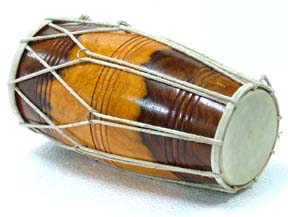
Dilruba
A Persian word meaning "heart-stealer" the dilruba has four mains strings. It is played in a seated position, the tabli sound box held in the lap of the performer and the eight- inch long dand, neck resting against the left shoulder. It is fingered by the left hand and bowed by the right. The bow is called the gaz. Since dilruba is bowed its ghori is styled like that of a sarangi but the dand is designed like the sitar. The frets help to locate the positions of the notes on the strings.
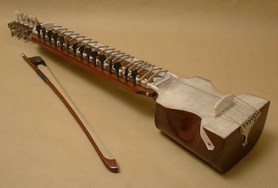 |
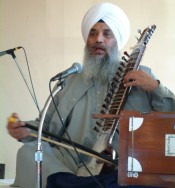 |
The influence of the sitar is only as far as the tying the parda to the tana of the dand is concerned. Out of the four main strings which are touched by the gaz, the first one is known as the baz. The sitar has a wooden tabli but the dilruba's is covered with skin. The major difference between the two is that the sitar is plucked with the mizrab, whereas the dilruba is bowed. The dilruba was evolved in the 17th century as an alternative to the sarangi which had become associated with courtesans. Early instruments were decorated with giltwork and the gaz bore two or three tassles, usually red or green, on one or both ends.
Galad/Kirla/Kato
This is a stick with a carved galad, squirrel, at the top. A cord fixed to the head jerks the galad up, producing a sharp click and at the same time bells tied to the galad's tail jingle. It is often painted and decorated with ribbons, tassels and feathers. Sometimes the face of a fish or any other animal may be seen adorning the galad. The galad is used by dancers, particularly in the Malwa region. It is seen nowhere else in India.
Kharchaam
Similar to the nagara, this war-drum with tassels all around the rim was mounted on horses, camels or elephants. It used thick mule-skin for the head to produce a loud note and was beaten to warn of impending attack. "Chot payee kharchaami dallan mukabala.' (A reference from Chandi di vaar of Guru Gobind Singh.)
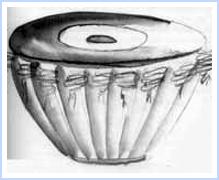
Nagara
The nagara is a war-drum. Its beat heralded the arrival of kings and princes and meant that the army was marching into battle. Often a pair of nagara of similar or varying size are played together. The drum is metal-bodied, with one head, the membrane of skin stretched taut across the head and held with leather strips. The head of the nagara may be a full 120 cm in diameter, the very smallest will not be less than 38 cm. It is beaten with a stick called a dagga or danka whose tip is wound with a long leather strip. The dagga may range from ordinary pieces of wood picked up along the wayside, to ornate wooden sticks, whittled and smoothened with pom-poms suspended from the ends. Some sticks may end in a sort of broom of thin strips to vary the sound of the instrument. The nagara itself may have a fringe of small tassels along its rim or it may have pendulous woollen pompoms suspended by string or wool at two to three points on the instrument.
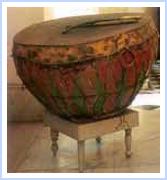
The nagara can be "tuned" to some extent: keeping it in the sun or heating it beside a fire tightens the skin producing a loud, sharp tone; swabbing the head with a wet cloth loosens the head so that the note is heavier and dimmer.
Pakhawaj
The sound of the pakhawaj is both sharp and deeply resonant. A tapering, wooden, hollow cylinder about 60 cm in length and 90 cm in diameter at the centre, the diameter of the right head is 16 cm and that of the left head is 25 cm. Both heads are covered with goatskin, the right thinner than the left. Both heads are covered with goatskin, the right thinner than the left. On the right head siyaahi, a paste of iron filings, glue, carbon, etc., is applied in the centre.
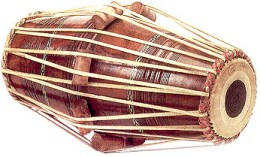
The note from the left head must be exactly one octave below that of the right head. To achieve this, the head is 'loaded": dhamma, kneaded dough, is smeared on the left head. This dough is removed after every performance. In some parts a paste of sooji, flour, and water or boiled rice, water and ashes is applied. It enhances the bass sound. Membranes can be tightened or loosened by adjusting the leather strips attached to their circmference. Gatte are inserted between alternate braces. The artiste keeps the pakhawaj on the ground in front or on the lap. The left hand plays the bass and the right the treble.
Rabab
Sikandar Zulqarnein, Alexander the Great, is credited with the invention of the rabab. It is one of the five basic instruments (veena, mridang, shehnai, sarangi and rabab). Mardana, the disciple of Guru Nanak, was a rababi and the instrument is mentioned in several verses of the Guru Granth Sahib.
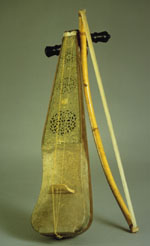
The body of the rabab is of wood and a skin stretched over the bowl creates a sound-box. Two groups of wires called taraps are stretched on the frame; a group of four above and seven below. A rabab with bands on the wires is called a nibadh and without bands an anbadh. It is played with a triangular wooden plectum. The old rababs were inlaid with ivory and the wires were wound on pegs of deer or sambar antler. Typically the mridang accompanies the rabab.
Sarangi
Sarangi is a popular bowed instrument in Punjab. It is about 24 inches long wooden instrument cut from a single log covered with parchment. A bridge is placed on the belly in the middle. The sides of the sarangi are pinched so as to bow it. This instrument usually has three major strings of varying thickness and the fourth string is made of brass, used for drone.
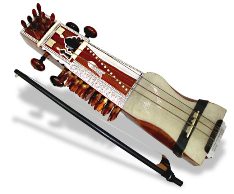
Modern sarangies contain thirty five to forty sympathetic strings running under the main strings. This accompanys the artists and is an ideal instrument for producing all types of Gamks and Meends.In Punjab, this instrument has been adopted by folk performers, naqqals, legendary performers, dhadies and devotional musicians. Mian Kale Khan has been one of the prominent sarangi players of Punjab.
Tabla
The tabla pair of tuned drums played with both hands, is the principal percussion instrument used in North Indian classical music.

The pair of drums consist of a high-pitched, precisely tuned right hand drum, the dahina (also called dayan or tabla), and a low-pitched, less precisely tuned left hand drum, the bayan. The dahina is responsible for many of the resonant ringing and clicking sounds (or bols). The bayan provides the bass and is recognizable for its swooping bass sounds which provide colorful embellishment. The combination of the two drums lends itself to a vast repertoire of bol combinations and permutations.
Taus
Taus means ‘peacock' in Persian and is derived from sitar and sarangi. It's body is shaped like a peacock and it is played with a bow. It has a sound hole at the ‘tail' portion of the instrument and stands on bird-feet carved in wood.
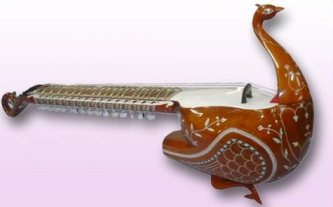 |
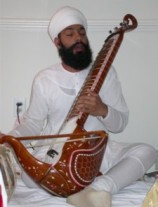 |
The taus is painted in all of the bright shades of the beautiful bird, the peacock, in its sound structure. Its long tail serves the purpose of the finger board of the instrument, upon which nineteen metal frets, elliptical in shape, are tied with cotton or silken cord. The lower portion, the head, carved to look just like the peacock, is covered with hide. The taus is played seated, with a bow. The parts of the bow include a wooden round stick, bow hair of horse tail, a wooden bridge, and a screw. The taus has sixteen sympathetic metal strings, along with its four playing strings. The taus is very similar to the dilruba in construction and in playing technique. However, the taus has a bigger sound box and therefore produces a much more resonant and mellow sound.
Previous